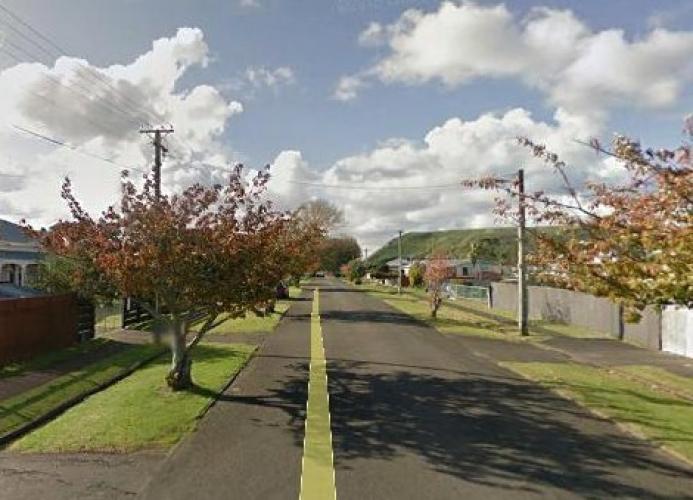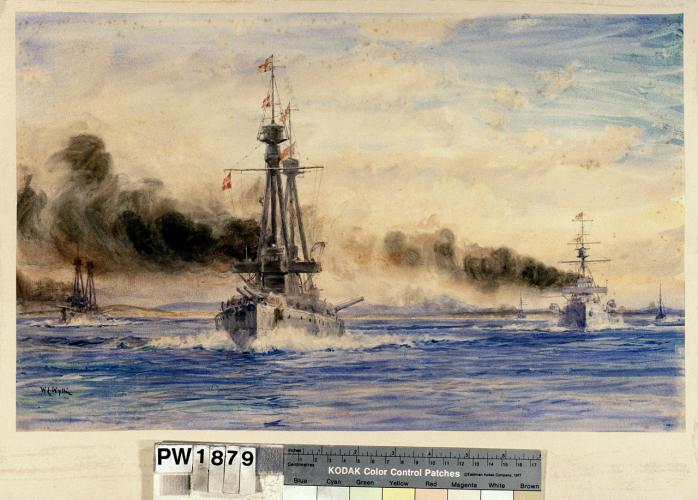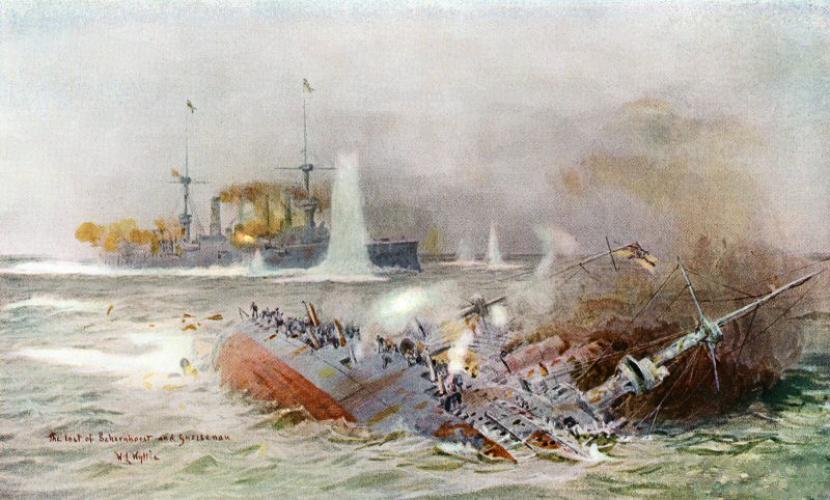072 Falkland Street Whanganui, street scene 2017
Reason for the name
This Whanganui street was named in honour of those who participated in a WW1 battle in the South Atlantic by the Royal Navy.
The Battle of the Falkland Islands was a naval action between the British Royal Navy and Imperial German Navy on 8 December 1914, during the First World War in the South Atlantic. The British, after a defeat at the Battle of Coronel on 1 November, sent a large force to track down and destroy the victorious German cruiser squadron. The battle is commemorated every year on 8 December in the Falkland Islands as a public holiday.
Admiral Graf Maximilian von Spee—commanding the German squadron of two armoured cruisers, SMS Scharnhorst and Gneisenau, the light cruisers SMS Nürnberg, Dresden and Leipzig, and three auxiliaries—attempted to raid the British supply base at Stanley in the Falkland Islands. A larger British squadron—consisting of the battlecruisers HMS Invincible and Inflexible, the armoured cruisers HMS Carnarvon, Cornwall and Kent, the armed merchant cruiser HMS Macedonia and the light cruisers HMS Bristol and Glasgow—had arrived in the port the day before.
Visibility was at its maximum, the sea was placid with a gentle breeze from the northwest, and the day was bright and sunny. The advanced cruisers of the German squadron were detected early. By nine o'clock that morning the British battlecruisers and cruisers were in hot pursuit of the five German vessels, these having taken flight in line abreast to the southeast. All except the auxiliary Seydlitz were hunted down and sunk.
Author: Poppy Places Trust
The British battlecruisers each mounted eight 12 in (305 mm) guns, whereas Spee's (Scharnhorst and Gneisenau), were equipped with eight 210 mm (8.3 in) pieces. Additionally, the battlecruisers could make 25.5 knots (47.2 km/h; 29.3 mph) against Spee's 22.5 knots (41.7 km/h; 25.9 mph); thus, the British battlecruisers not only significantly outgunned their opponents, but could outrun them too. The obsolete pre-dreadnought battleship HMS Canopus had been grounded at Stanley to act as a makeshift defence battery for the area.
Spee's squadron
At the outbreak of hostilities, the German East Asia Squadron commanded by Spee was outclassed and outgunned by the Royal Navy and the Imperial Japanese Navy. Spee and the High Command did not believe Germany's Asian possessions could be defended and doubted the squadron could even survive in that theatre. Spee wanted to get his ships home and began by heading southeast across the Pacific, although he was pessimistic about their chances.
Spee's fleet won the Battle of Coronel off the coast of Coronel, Chile, on 1 November 1914, where his ships sank the cruisers HMS Good Hope (Admiral Cradock's flagship) and Monmouth. After the battle, on 3 November, Scharnhorst, Gneisenau and Nürnberg entered Valparaíso harbour and were welcomed as heroes by the German population. Von Spee declined to join in the celebrations; when presented with a bouquet of flowers, he refused them, commenting that "these will do nicely for my grave". As required under international law for belligerent ships in neutral countries, the ships left within 24 hours, moving to Mas Afuera, 400 mi (350 nmi; 640 km) off the Chilean coast. There they received news of the loss of the cruiser SMS Emden, which had previously detached from the squadron and had been raiding in the Indian Ocean. They also learned of the fall of the German colony at Tsingtao in China, which had been their home port. On 15 November, the squadron moved to Bahia San Quintin on the Chilean coast, where a ceremony was held to award 300 Iron Crosses, second class, to crew members, and an Iron Cross first class to Admiral Spee.
Spee's officers counseled a return to Germany. The squadron had used half its ammunition at Coronel; the supply could not be replenished, and it was difficult even to obtain coal. Intelligence reports suggested that the British ships HMS Defence, Cornwall and Carnarvon were stationed in the River Plate, and that there had been no British warships at Stanley when recently visited by a steamer. Spee had been concerned about reports of a British battleship, Canopus, but its location was unknown. On 26 November, the squadron set sail for Cape Horn, which they reached on 1 December, then anchored at Picton Island, where they stayed for three days distributing coal from a captured British collier, the Drummuir, and hunting. On 6 December, the British vessel was scuttled and its crew transferred to the auxiliary Seydlitz. The same day Spee proposed to raid the Falkland Islands before setting course for Germany. The raid was unnecessary because the squadron now had as much coal as it could carry. Most of Spee's captains opposed the raid, but he nevertheless decided to proceed.
British preparations
On 30 October, retired Admiral of the Fleet Sir John Fisher was reappointed First Sea Lord to replace Admiral Prince Louis of Battenberg, who had been forced to resign because of public outcry against a perceived German prince running the British navy. On 3 November, Fisher was advised that Spee had been sighted off Valparaíso and acted to reinforce Cradock by ordering Defence, already sent to patrol the eastern coast of South America, to reinforce his squadron. On 4 November, news of the defeat at Coronel arrived. The blow to British naval prestige was palpable, and the English public was rather shocked. As a result, the battlecruisers Invincible and Inflexible were ordered to leave the Grand Fleet and sail to Plymouth for overhaul and preparation for service abroad. Chief of Staff at the Admiralty was Vice-Admiral Doveton Sturdee. Fisher had a long-standing disagreement with Sturdee, who had been one of those calling for his earlier dismissal as First Sea Lord in 1911, so he took the opportunity to appoint Sturdee Commander-in-Chief, South Atlantic and Pacific, to command the new squadron from Invincible.
On 11 November, Invincible and Inflexible left Devonport, although repairs to Invincible were incomplete and she sailed with workmen still aboard. Despite the urgency of the situation and their maximum speed of around 25 knots (46 km/h; 29 mph), the ships were forced to cruise at 10 knots (19 km/h; 12 mph) to conserve coal in order to complete the long journey south across the Atlantic. The two ships were also heavily loaded with supplies. Although secrecy of the mission was considered important so as to surprise Spee, Lieutenant Hirst from Glasgow heard locals discussing the forthcoming arrival of the ships while ashore at Cape Verde on 17 November; however the news did not reach Spee. Sturdee arrived at the Abrolhos Rocks on the 26 November, where Rear Admiral Stoddart awaited him with the remainder of the squadron.
Sturdee announced his intention to depart for the Falkland Islands on 29 November. From there, the fast light cruisers Glasgow and Bristol would patrol seeking Spee, summoning reinforcements if they found him. Captain Luce of Glasgow, who had been at the battle of Coronel, objected that there was no need to wait so long and persuaded Sturdee to depart a day early. The squadron was delayed during the journey for 12 hours when a cable towing targets for practice-firing became wrapped around one of Invincible's propellers, but the ships arrived on the morning of 7 December. The two light cruisers moored in the inner part of Stanley Harbour, while the larger ships remained in the deeper outer harbour of Port William. Divers set about removing the offending cable from Invincible; Cornwall's boiler fires were extinguished to make repairs, and Bristol had one of her engines dismantled. The famous ship SS Great Britain—reduced to a coal bunker—supplied coal to Invincible and Inflexible. The armed merchant cruiser Macedonia was ordered to patrol the harbour, while Kent maintained steam in her boilers, ready to replace Macedonia the next day, 8 December; Spee's fleet arrived in the morning of the same day.
An unlikely source of intelligence on the movement of the German ships was from Mrs Muriel Felton, wife of the manager of a sheep station at Fitzroy, and her maids Christina Goss and Marian Macleod. They were alone when Felton received a telephone call from Port Stanley advising that German ships were approaching the islands. The maids took turns riding to the top of a nearby hill to record the movements of the ships, which Felton relayed to Port Stanley by telephone. Her reports allowed Bristol and Macedonia to take up the best positions to intercept. The Admiralty later presented the women with silver plates and Felton received an OBE for her actions.
Casualties and damage were extremely disproportionate; the British suffered only very lightly. Admiral Spee and his two sons were among the German dead. Rescued German survivors, 215 total, became prisoners on the British ships. Most were from the Gneisenau, nine were from Nürnberg and 18 were from Leipzig. Scharnhorst was lost with all hands. One of Gneisenau's officers who lived had been the sole survivor on three different guns. He was pulled from the water saying he was a first cousin of the British commander (Stoddart).
Of the known German force of eight ships, two escaped: the auxiliary Seydlitz and the light cruiser Dresden, which roamed at large for a further three months before her captain was cornered by a British squadron (Kent, Glasgow and Orama) off the Juan Fernández Islands on 14 March 1915. After fighting a short battle, Dresden's captain evacuated his ship and scuttled her by detonating the main ammunition magazine.
As a consequence of the battle, the German East Asia Squadron, Germany's only permanent overseas naval formation, effectively ceased to exist. Commerce raiding on the high seas by regular warships of the Kaiserliche Marine was brought to an end. However, Germany put several armed merchant vessels into service as commerce raiders until the end of the war.







